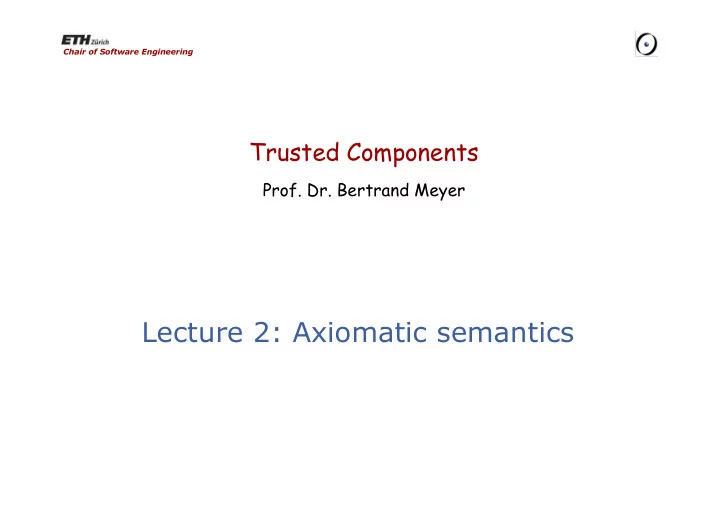

Chair of Software Engineering Trusted Components Prof. Dr. Bertrand Meyer Lecture 2: Axiomatic semantics
Reading assignment for next week Ariane paper and response (see course page) Axiomatic semantics chapter in Introduction to the Theory of Programming Languages (also accessible from course page)
Axiomatic semantics Floyd (1967), Hoare (1969), Dijkstra (1978) Purpose: Describe the effect of programs through a theory of the underlying programming language, allowing proofs
What is a theory? (Think of any mathematical example, e.g. elementary arithmetic ) A theory is a mathematical framework for proving properties about a certain object domain Such properties are called theorems Components of a theory: Grammar (e.g. BNF), defines well-formed formulae (WFF) Axioms: formulae asserted to be theorems Inference rules: ways to prove new theorems from previously obtained theorems
Notation Let f be a well-formed formula Then ⊢ f expresses that f is a theorem
Inference rule An inference rule is written f 1 , f 2 , …, f n ___________ f 0 It expresses that if f 1 , f 2 , … f n are theorems, we may infer f 0 as another theorem
Example inference rule “Modus Ponens” (common to many theories): p, p ⇒ q ________ q
How to obtain theorems Theorems are obtained from the axioms by zero or more* applications of the inference rules. *Finite of course
Proof techniques Proof by contradiction Deduce a contradiction from ¬ f Conditional proof Prove e ⇒ f by assuming e and inferring f Caution: use e only within the scope of the conditional proof! (See book chapter)
Example: a simple theory of integers Grammar: Well-Formed Formulae are boolean expressions i1 = i2 i1 < i2 ¬ b1 b1 ⇒ b2 where b1 and b2 are boolean expressions, i1 and i2 integer expressions An integer expression is one of 0 A variable n f’ where f is an integer expression (represents “successor”)
An axiom and axiom schema ⊢ 0 < 0’ ⊢ f < g ⇒ f’ < g’
An inference rule P (0), P (f) ⇒ P (f’) ________________ P (f)
The theories of interest Grammar: a well-formed formula is a “Hoare triple” Instructions {P} A {Q} Informal meaning: A, started in any state satisfying P, will terminate Assertions in a state satisfying Q
Partial vs total correctness {P} A {Q} Total correctness: A, started in any state satisfying P, will terminate in a state satisfying Q Partial correctness: A, started in any state satisfying P, will, if it terminates , yield a state satisfying Q
Axiomatic semantics “Hoare semantics” or “Hoare logic”: a theory describing the partial correctness of programs, plus termination rules
What is an assertion? Predicate (boolean-valued function) on the set of computation states True s False State True : Function that yields True for all states False : Function that yields False for all states P implies Q: means ∀ s : State , P ( s ) ⇒ Q ( s ) and so on for other boolean operators
Another view of assertions We may equivalently view an assertion P as a subset of the set of states (the subset where the assertion yields True): True P State True : Full State set False : Empty subset implies : subset (inclusion) relation and : intersection or : union
Elementary mathematics Assume we want to prove, on integers {x > 0} A {y ≥ 0} [1] but have actually proved {x > 0} A {y = z ^ 2} [2] We need properties from other theories, e.g. arithmetic
“EM”: Elementary Mathematics The mark [EM] will denote results from other theories, taken (in this discussion) without proof Example: y = z ^ 2 implies y ≥ 0 [EM]
Rule of consequence {P} A {Q}, P’ implies P, Q implies Q’ _____________________________ {P’} A {Q’}
Rule of conjunction {P} A {Q}, {P} A {R} ________________ {P} A {Q and R}
Axiomatic semantics for a programming language Example language: Graal (from Introduction to the theory of Programming Languages ) Scheme: give an axiom or inference rule for every language construct
Skip {P} skip {P}
Abort { False } abort {P}
Sequential composition {P} A {Q}, {Q} B {R} _________________ {P} A ; B {R}
Assignment axiom (schema) {P [e / x]} x := e {P} P [e/x] is the expression obtained from P by replacing (substituting) every occurrence of x by e.
Substitution x [x/x] = x [y/x] = x [x/y] = x [z/y] = 3 ∗ x + 1 [y/x] =
Applying the assignment axiom
Recommend
More recommend